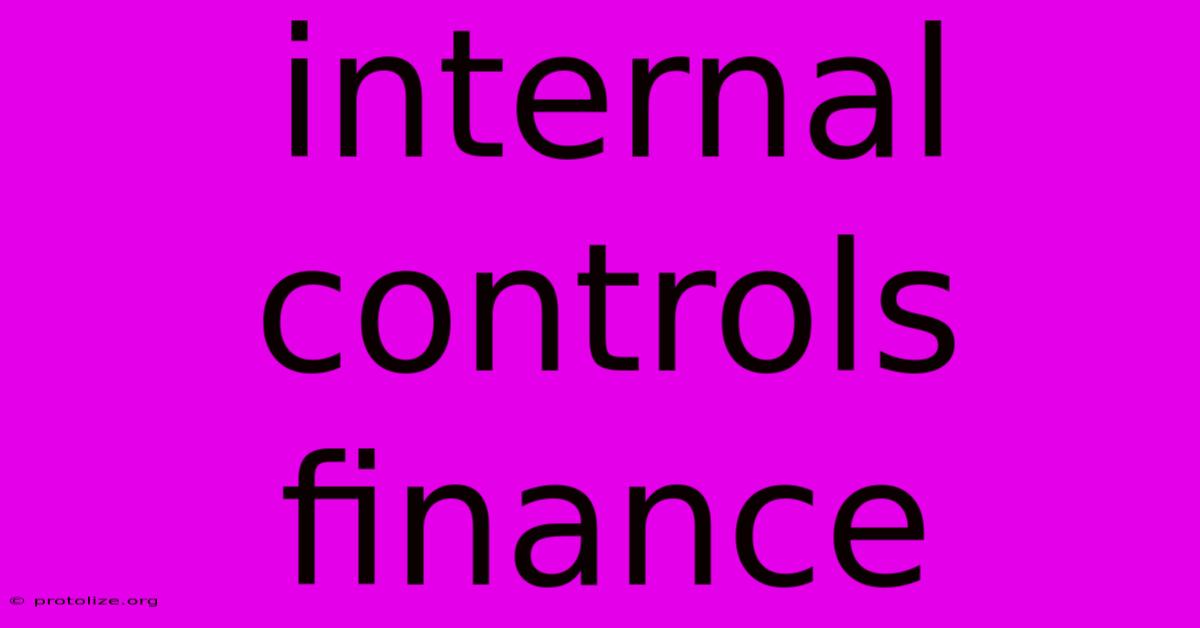Internal Controls Finance

Discover more detailed and exciting information on our website. Click the link below to start your adventure: Visit Best Website mr.cleine.com. Don't miss out!
Table of Contents
Internal Controls in Finance: A Comprehensive Guide
Internal controls are the backbone of any sound financial system. They're the processes, procedures, and policies designed to safeguard assets, ensure the accuracy and reliability of financial reporting, promote operational efficiency, and comply with applicable laws and regulations. For finance professionals, understanding and implementing robust internal controls is paramount. This guide dives deep into the world of internal controls in finance, exploring key concepts, best practices, and the potential pitfalls of inadequate controls.
Understanding the COSO Framework
The Committee of Sponsoring Organizations of the Treadway Commission (COSO) framework is the globally recognized standard for internal control. It provides a comprehensive framework for evaluating and improving an organization's internal control system. COSO's five key components are:
1. Control Environment:
This sets the tone at the top. A strong control environment fosters a culture of ethics and integrity, emphasizing accountability and commitment to internal controls. Key aspects include:
- Ethical values and commitment to competence: Hiring qualified individuals and fostering a culture of ethical behavior.
- Board of directors' oversight: Active participation from the board in overseeing the organization's risk management and internal control system.
- Management's philosophy and operating style: Establishing clear expectations and accountability for internal control effectiveness.
- Organizational structure: Establishing clear lines of authority and responsibility.
- Commitment to attracting, developing, and retaining competent employees: Investing in employee training and development programs.
2. Risk Assessment:
This involves identifying and analyzing potential risks that could affect the achievement of the organization's objectives. A thorough risk assessment considers both internal and external factors, including:
- Financial risks: Credit risk, market risk, liquidity risk.
- Operational risks: Process failures, system breakdowns, fraud.
- Compliance risks: Non-compliance with laws and regulations.
Effective risk assessment is crucial for prioritizing resources and implementing appropriate controls.
3. Control Activities:
These are the specific actions taken to mitigate identified risks. Examples include:
- Authorization: Approvals for transactions and activities.
- Performance reviews: Regular monitoring of performance indicators.
- Information processing: Use of secure systems and data protection measures.
- Physical controls: Security of assets and access controls.
- Segregation of duties: Separating authorization, recording, and custody functions to prevent fraud.
4. Information and Communication:
Effective communication is essential for ensuring that all stakeholders understand their roles and responsibilities in the internal control system. This includes:
- Internal communication: Clear communication within the organization about internal control policies and procedures.
- External communication: Communication with external stakeholders, such as auditors and regulators.
- Information systems: Reliable and accurate information systems to support decision-making.
5. Monitoring Activities:
Ongoing monitoring is crucial to ensure the effectiveness of the internal control system. This includes:
- Regular reviews: Periodic assessments of the effectiveness of controls.
- Supervisory checks: Day-to-day supervision of employees and their adherence to procedures.
- Internal audits: Independent assessments of the internal control system.
- External audits: Independent audits by external auditors.
Implementing Effective Internal Controls in Finance
Implementing effective internal controls requires a multi-faceted approach. Here are some key considerations:
- Segregation of duties: This prevents fraud and errors by ensuring that no single individual has complete control over any process.
- Authorization procedures: All transactions should require proper authorization at appropriate levels.
- Reconciliations: Regularly reconcile bank accounts, accounts receivable, and accounts payable to detect discrepancies.
- Data security: Protect sensitive financial data through encryption and access controls.
- Regular audits: Conduct both internal and external audits to ensure compliance and identify weaknesses.
- Employee training: Educate employees about their responsibilities regarding internal controls.
Consequences of Weak Internal Controls
Weak internal controls can have serious consequences, including:
- Financial losses: Theft, fraud, and errors can lead to significant financial losses.
- Reputational damage: Weak controls can damage an organization's reputation and erode investor confidence.
- Legal and regulatory penalties: Non-compliance with laws and regulations can result in hefty fines and penalties.
- Operational inefficiencies: Inefficient processes can waste resources and hinder productivity.
Conclusion:
Internal controls are not merely a compliance requirement; they are essential for the long-term health and success of any organization. By implementing a robust internal control system based on the COSO framework and best practices, finance professionals can protect assets, ensure accurate financial reporting, and enhance operational efficiency. Investing in strong internal controls is an investment in the future of the organization.

Thank you for visiting our website wich cover about Internal Controls Finance. We hope the information provided has been useful to you. Feel free to contact us if you have any questions or need further assistance. See you next time and dont miss to bookmark.
Featured Posts
-
Study Accounting And Finance
Dec 16, 2024
-
Masters Of Finance Mit
Dec 16, 2024
-
Budgeting And Personal Finance Dlc
Dec 16, 2024
-
Anf Auto Finance North Shepherd Drive Houston Tx
Dec 16, 2024
-
Online Shopping With Finance
Dec 16, 2024
